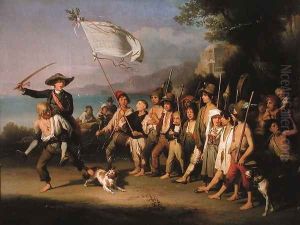J. Kirner Paintings
Johann Baptist Kirner, often known as J. Kirner, was a German painter born on March 25, 1806, in Furtwangen im Schwarzwald, a small town in the Black Forest region of Germany. His artistic talents became evident at a young age, and he was encouraged to pursue an education in art. Kirner's early work was influenced by the Biedermeier style, which was popular in German-speaking countries during the first half of the 19th century. This style was characterized by a sense of order and intimacy, often with a focus on domestic life and landscapes.
Kirner received his formal art education at the Academy of Fine Arts in Munich, where he studied under the guidance of prominent artists such as Peter von Cornelius and Wilhelm von Kaulbach. These teachers were associated with the Nazarene movement, which sought to revive the spirituality and simplicity of medieval and early Renaissance art. Although Kirner was influenced by his teachers, his style remained distinct, often infused with a sense of realism and attention to detail.
Throughout his career, Kirner specialized in genre painting, a style of painting depicting scenes from everyday life, often with a narrative element. His works often illustrated the customs, dress, and domestic life of the Black Forest region, capturing the essence of 19th-century rural Germany. Kirner's genre scenes were well-received for their charm, warmth, and detailed portrayal of peasant life.
Johann Baptist Kirner's contribution to German art was significant in the way he documented the culture and traditions of his homeland. His paintings not only serve as historical records but also showcase his skill in using light and shadow to create depth and atmosphere. His works were exhibited and appreciated during his lifetime, and he gained a reputation as a skilled genre painter.
Kirner's legacy includes not only his paintings but also his impact on the art community in the Black Forest region. He inspired a number of younger artists, contributing to the development of a regional style that celebrated local identity and the natural beauty of the area.
Johann Baptist Kirner passed away on June 6, 1866, in Karlsruhe, Germany. His body of work continues to be studied and admired for its contribution to 19th-century German genre painting, and many of his pieces are held in collections in Germany and around the world. Kirner's art remains an important part of the cultural heritage of the Black Forest region, and his paintings are a testament to the rich history and traditions of rural Germany.
